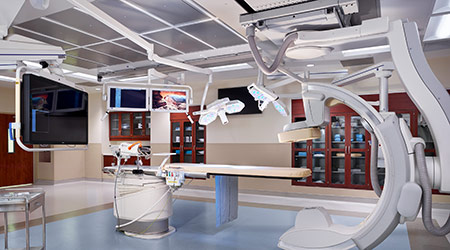Here are key contextual and analytical considerations as well as eight keys to decisively optimize strategy, planning and right sizing for structural heart program and endovascular facilities
Growth + Analysis
“Over the last decade transcatheter therapeutic devices for structural heart and vascular diseases have seen remarkable advancements in technology. Heart diseases that previously required open heart surgery are now often treated through blood vessels in the leg or arm utilizing these specialized catheters,” said Dr. Nathan Boyer, a cardiologist at Vancouver Clinic in Vancouver, Wash., whose medical special interests include interventional cardiology, including catheter-based treatment of coronary artery disease, structural heart disease including transcatheter aortic valve replacement (TAVR), transradial cardiac catheterization, peripheral arterial and venous disease.
Cardiologist and heart surgeons can now offer less invasive and lower risk procedures to patients with results that are just as good and often better than traditional surgery.
Interventional cardiologists and heart surgeons are now working together in “heart teams” and expanding catheter-based interventions far beyond coronary artery stenting.
Transcatheter aortic valve replacement (TAVR) is the flagship procedure of this revolution and has been performed over 100,000 times in the US alone.
Rapid Growth + Outlook
Rapid, enthusiastic reception of TAVR and similar procedures by patients and the entire medical community has been no surprise
As their popularity grows, healthcare leaders are looking to expand their programs to accommodate these innovative procedures and patient demand for them.
Key to the transition of the spaces themselves is where they occur: freestanding angiography suites, cardiac catheterization labs, or hybrid ORs— so named because they are a mixture of a lab and an OR. This is a novel concept: for high acuity procedures to take place outside OR areas. The lower the acuity, the broader the patient pool, which makes TAVR a highly desirable addition to the procedure offerings.
When complications do arise, they can be intense and practitioners may not have time to transfer a patient, so it is important to ensure that the right competencies are present to support any procedures that are added.
TAVR, as well as other new procedures on the horizon, are pushing the spaces they currently occupy.
There are strategies that skilled practitioners can decisively do to gradually build their programs in concert with the assessed need.
“This is just the beginning of a new era of transcatheter therapeutics across the medical spectrum: there are several transcatheter mitral valve device therapies in addition to several other transcatheter aortic valve devices that are currently under investigation by the FDA and other left atrial appendage occlusion devices on the horizon,” said Boyer.
The experience with TAVR in the United States and worldwide has proven that structural heart and transcatheter valvular therapeutics are safe and should be available for most communities as they’ve been proved to be safe and effective.
As procedures become more complex, having a hybrid OR or a an advanced cath lab that has the ability to adapt to new procedures will keep hospitals relevant.
Volumes + Analysis
As healthcare leaders evaluate, they need a way to accurately predict volumes and patient flow.
Certain volumes and provider competencies are required to make TAVR a feasible option for mid-size facilities.
There is a longstanding debate among cardiologists and heart surgeons about access versus volume. For procedures like TAVR, is it just the referring high volume centers doing it? Or is the procedure allowed to infiltrate the entire community?
When TAVR is potentially approved for low-risk procedures (predicted around 2020), it could become standard care for aortic valve replacement, as open-heart surgery will be reserved for cases where there is a secondary reason for surgery, such as bypass, or fixing another valve, etc.
Europe is also several years ahead of the US in TAVR, using the same devices and already moving toward a low-risk standard of care.
All these factors contribute to the theory that TAVR is non-inferior for the low-risk population, that it will potentially be approved by the FDA for commercial use.
Leaders can evaluate their current case mix and what type of patients would benefit from providing procedures in-house that had previously been transferred out.
All this depends on the competencies inherent in the existing team, the demographics, and what competing facilities are also present in the region.
Risk assessments are also important to ensure available support for procedure and post-procedure issues that may arise.
With continued advancements in this technology, it’s possible that structural heart procedures and endovascular therapeutics will become much like interventional coronary procedures today.
“It is anticipated that these procedures will end up much like interventional cardiac procedures are today. Where a decade ago, only tertiary centers were doing these procedures, now they are so commonplace, they are performed even in community hospitals,” said Dr. Boyer.
It is projected that, in ten years, hospitals across the country will be offering doing TAVR as a matter of course.
Currently, for instance, TAVR is only offered at two to three hospitals and two to three surgery centers, out of approximately 15, in central Texas. This scenario poses a question to area healthcare leaders whether physician training or facility requirements explain why this geography is under supported to serve TAVR demand?
Eight keys to decisive planning
1 – How much does technology influence planning decisions?
When leaders are considering adding extended interventional cardio procedures like TAVR, they require analytical information to track volume potential and inform decision making.
Each device has its own context: MCDR, CMS, Medicare criteria, high volume centers, black and white, and CMS documents to support them.
There are different manufacturers for the types of devices: Edwards, Medtronic, Watchman, with more data available on some models than others.
These numbers are dynamic. For example, recently a big panel included Medicare discussing whether or not they should change their numbers because TAVR has evolved so rapidly that increased access may be necessary.
The numbers are clearer for some devices than others, so it is ideal to provide a hybrid operating environment that can encompass the needs of several practitioners and procedures.
2 – What role does forecasting play in planning for future success?
While it is not possible to make explicit recommendations about financial viability of the service, analysts and project teams can estimate the success of a proposed program based on the number of cases anticipated for a facility.
The financial viability is not factored by the cost of the TAVR itself, but the additional imaging and scans, and the shorter hospital stays. The TAVR device is approx. $30,000, a surgical aortic valve is $10,000, but the funds saved by getting a patient home within five days and the margins from doing a CT scan and an angiogram make up for the cost gap.
With increasing devices becoming available in the next 2-5 years, it’s likely that cost pricing for TAVR devices will become more competitive because of expanding market forces.
If healthcare leaders decide to move forward, project teams can help determine how many labs are needed, estimate size and equipment requirements, and plan the support areas needed to care for patients across the continuum.
Leaders need a way to credibly predict volume and how much facility capacity they would need to service that volume.
In a tight market where many players are competing for a share, it might be hard for small hospitals to compete, but having a TAVR program could be a differentiator.
Offering TAVR adds a level of prestige to the hospital where the hospital’s reputation in the community is enhanced.
“Hospitals that have opened a TAVR center generate more referral volume. Even if the volume of TAVR itself is less robust than predicted, there will be an increase in related procedures, such as angiograms. It is difficult to gather metrics on this connection, but the connection exists,” said Dr. Boyer.
3 – How can a TAVR program help solidify market position?
Leaders must also look at who else is offering TAVR in the region and the supporting demographics to avoid flooding the market.
The patients who are getting TAVR are an older patient population who often don’t want to go to a “big hospital” or academic center. They prefer their community hospital where they feel comfortable.
Even in a community with multiple dominant TAVR centers, if the panel of patients is significant enough to support a cardiology group with 20 cardiologists, there will almost certain be enough TAVR volume to support the program.
A community with one dominant provider is not off limits to smaller entities. It is worth investing in a TAVR program if the volume is present to support it.
One of the first things to determine is who is dominating the volume.
There may be other smaller hospitals that could unify to form an additional program and compete with the dominant one.
This effort will only be worthwhile, however, if the case load is there to support it.
Data analytics experts – part of experienced project teams – have access to tools to input market types (by user, county, etc.) and make assessments about what the case load will be to inform decision making.
4 – How can programs optimize the available space through flexible application and right sizing?
Once the estimated case load is determined, designers can right-size the facility, ensuring that they optimize rooms.
“The hybrid OR is really just one room, but it can be available to multiple service lines. Vascular surgeons use hybrid ORs to convert a closed abdominal aortic aneurism repair to an open abdominal aortic aneurism repair if needed. Neuro-intervention procedures for strokes can also be completed in hybrid ORs,” said Dr. Boyer.
Administrators may argue that the hybrid OR is unnecessary, encouraging practitioners to do more with less. Right-sizing and choosing the correct number of cath labs, hybrid ORs, full operating suites, etc. requires a solid argument. Frequently it is based on scheduling, which is a function of volume.
Consider an example: one hospital just built its sixth hybrid lab. Growth was triggered by the electrophysiology volume.
The hospital has one vascular cath lab that is dedicated to vascular and interventional radiology cases, two coronary labs, and one electrophysiology lab dedicated to heart rhythm/pacemakers, etc. The hospital also had the hybrid OR that was shared, using block scheduling to ensure surgeons had enough time to perform their OR procedures.
There were four electrophysiologists who needed to expand their practice to meet patient volumes. Those procedures are reimbursed well so it wasn’t hard to convince hospital leaders that this was necessary.
Benchmarking the capacities of rooms used for similar procedures across the country can provide insight.
Financial feasibility and quality drivers on the front end are unique to the organizations and can be better understood in the context of the demographic data.
Once those numbers are available, leaders can define an efficient solution that optimizes available resources to meet patient demand.
The types of ORs included in a facility are key to planning, so once clients provide current and projected future volume, designers can make a plan. It is important to remember that it’s not all the science of crunching numbers, but also an art of incorporating just the right amount of flexibility to handle shifting volumes in the future.
Flexibility is important because when the market shifts, hospitals that have trouble keeping up with their demand can feel a negative impact on their business. Design teams need to have a plan in place for future expansion or change, and the key to doing that successfully is in-house expertise. Someone who knows what is up and coming in a particular area, such as medical equipment, can help advise clients and colleagues on how best to optimize the latest industry trends.
5 – Where is the tipping point for program viability?
A tipping point will emerge, helping leaders to determine the ideal number of cases for that facility.
That number will help them interpret need. It is also key to consider that TAVR may attract patients to other services, which will cause an overall increase in surgical volume.
The structure of referrals changes with the introduction of a TAVR program as well. Patients may go onto surgery, rather than TAVR, but the facility that has the TAVR program still gets the referral, so there may be an uptick in referral volume, but not in actual TAVR procedures, making it a challenge to capture accurate numbers.
Most facilities have three to four catheter labs and a hybrid operating room.
6 – How important is physician involvement?
In the past, leaders and practitioners may have had a tendency to look at labs in a siloed fashion, not maximizing the space for the most efficient use.
For example, a facility may have an electrophysiologist, an interventional cardiologist, and a vascular surgeon - all demanding their own labs.
Situations such as this provide a prime opportunity for leaders to encourage collaborative use of shared spaces by showing practitioners that the volume is more likely to support two labs rather than three. This is no small task based on what’s coming through the ER.
It can be challenging to get high-volume proceduralists to share space so it is important to ensure stakeholders are on the same page and open to being flexible with how and when they do procedures for a program to work.
When the numbers are available to back up the plan, practitioners are more likely to be innovative in maximizing the existing space. Once they are built, leaders across all fields are interested in what can be done in hybrid operating rooms, and how to optimize their use. These labs also tend to have the best radiation protection as they feature the most contemporary equipment.
To consult physicians who have questions about changing the way they work or adopt new technology, the key is involving them in the planning process.
Savvy analysts and teams listen to their input and concerns, incorporating their feedback into the design.
Physicians are more willing to adapt to change when they feel they have had some agency in the decision-making process.
Often, physician feedback is critical in helping to drive the design. Their experience informs the design and they are happy working in an environment they helped shape. Decisions about new designs are most often physician-influenced. Administrators rarely suggest a new facility or piece of equipment without physicians asking for it.
7 – How can programs make the most of available space?
Flexibility is paramount. There may be pressure to provide a separate lab for each specialty, but oversized, inflexible spaces are less efficient.
As long as the spaces are adequate to support TAVR and other procedures, the objective is to maximize the facility’s ability to provide the best care for TAVR patients.
Many hospitals divide cardiology into surgical and non-surgical with interventional/structural practitioners in the middle. Many programs are emphasizing these procedures because they are so effective.
There are some best practices—smart scheduling, multipurpose use, cost optimization—that can go a long way toward making things run smoothly.
The best place to start is to understand current processes and how patients flow through the hospital.
For example, if the preadmission process is robust, the hospital may need fewer prep/recovery bays because much of the prework is done before the patient arrives.
The procedure rooms can be right-sized based on volumes for peak efficiency and flexibility.
Virtual and physical mockups can be used to ensure that the rooms are ideally suited to their purpose, and often reveal options to optimize available space.
“Hybrid ORs can be used as first-line for emergency procedures (although they generally are not as other rooms are available), despite having the adaptability to be used in such incidences when necessary. These are best conducted as outpatient procedures, where scheduling is easier,” said Dr. Boyer. “Working with experienced project teams is key to optimizing the space leading to the most effective solutions.
8 – How can a program customize this approach to best serve their patient population?
Some organizations have goals of 85% efficiency, depending on their scheduling, so they have flexibility for emergency procedures.
Teaching hospitals and community hospitals serve different needs and may have different approaches, so there is no one-size-fits-all solution.
The key is to start with an objective viewpoint and then customize based on the unique needs of each organization and how they operate.
Every organization has a “wish list” that may not be in alignment with their actual needs, and they often are challenged to spot opportunities to improve efficiency inside their facility.
Analysts and project teams offer perspective that can lead to better patient flow and throughput.
Josh Halon, RN, MSN, EDAC, is Director, Planning, with BSA LifeStructures. Timothy J. Spence, AIA, ACHA, LEED AP BD+C, is National Healing Market Leader with BSA LifeStructures. Daniel G. Carl, P.E., is the Regional Office Leaders for BSA Lifestructures in Austin, Texas

 Building Disaster Resilience Through Collaboration
Building Disaster Resilience Through Collaboration Amae Health Expands to New York City
Amae Health Expands to New York City Hospital for Special Surgery Opens Two New Facilities in New Jersey
Hospital for Special Surgery Opens Two New Facilities in New Jersey Should We Be Testing Toilet Water in Patient Restrooms?
Should We Be Testing Toilet Water in Patient Restrooms? Healthcare Union Petitions for Increased Staff Safety at HCA Florida Hospitals
Healthcare Union Petitions for Increased Staff Safety at HCA Florida Hospitals